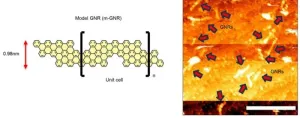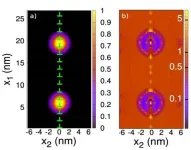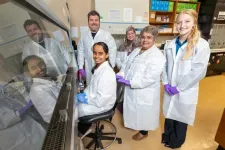(Press-News.org) Researchers from Ann & Robert H. Lurie Children’s Hospital of Chicago and colleagues reported for the first time that a genetic biomarker may be able to help predict the severity of food allergy reactions. Currently there is no reliable or readily available clinical biomarker that accurately distinguishes patients with food allergies who are at risk for severe life-threatening reactions versus more mild symptoms. Findings were published in the Journal of Allergy and Clinical Immunology.
Dr. Lang and colleagues found that the presence of an enzyme isoform called α-tryptase, which is encoded by the TPSAB1 gene, correlates with increased prevalence of anaphylaxis or severe reaction to food as compared to subjects without any α-tryptase.
“Determining whether or not a patient with food allergies has α-tryptase can easily be done in clinical practice using a commercially available test to perform genetic sequencing from cheek swabs,” said lead author Abigail Lang, MD, MSc, attending physician and researcher at Lurie Children’s and Assistant Professor of Pediatrics at Northwestern University Feinberg School of Medicine. “If the biomarker is detected, this may help us understand that the child is at a higher risk for a severe reaction or anaphylaxis from their food allergy and should use their epinephrine auto-injector if exposed to the allergen. Our findings also open the door to developing an entirely new treatment strategy for food allergies that would target or block α-tryptase. This is an exciting first step and more research is needed.”
Tryptase is found mainly in mast cells, which are white blood cells that are part of the immune system. Mast cells become activated during allergic reactions. Increased TPSAB1 copy number which leads to increased α-tryptase is already known to be associated with severe reactions in adults with Hymenoptera venom allergy (or anaphylaxis following a bee sting).
Dr. Lang’s study included 119 participants who underwent TPSAB1 genotyping, 82 from an observational food allergy cohort at the National Institute of Allergy and Infectious Diseases (NIAID) and 37 from a cohort of children who reacted to peanut oral food challenge at Lurie Children’s.
“We need to validate our preliminary findings in a much larger study, but these initial results are promising,” says Dr. Lang. “We also still need a better understanding of why and how α-tryptase makes food allergy reactions more severe in order to pursue this avenue for potential treatment.”
Rajesh Kumar, MD, MSc, from Lurie Children’s is the co-senior author on the study. Dr. Kumar is the Interim Division Head of Allergy and Immunology and Professor of Pediatrics at Northwestern University Feinberg School of Medicine.
This work was supported in part by the Midwest Allergy Research Institute (MARI) Food Allergy Pilot Research Award and NIAID-sponsored T32 grant AI083216. This project was funded in part with federal funds from the Division of Intramural Research of the National Institute of Allergy and Infectious Diseases, NIH. This project has also been funded in whole or in part with federal funds from the National Cancer Institute, National Institutes of Health, under Contract No. 75N91019D00024.
Research at Ann & Robert H. Lurie Children’s Hospital of Chicago is conducted through Stanley Manne Children’s Research Institute. The Manne Research Institute is focused on improving child health, transforming pediatric medicine and ensuring healthier futures through the relentless pursuit of knowledge. Lurie Children’s is a nonprofit organization committed to providing access to exceptional care for every child. It is ranked as one of the nation’s top children’s hospitals by U.S. News & World Report. Lurie Children’s is the pediatric training ground for Northwestern University Feinberg School of Medicine.
END
Genetic biomarker may predict severity of food allergy
Offers potential for determining the risk of severe reactions for patients and families with food allergies
2023-09-20
ELSE PRESS RELEASES FROM THIS DATE:
Researchers reveal novel AI-based camera alert system to promote coexistence between tigers and humans
2023-09-20
For decades, wildlife biologists have dreamt of a “smart” camera alerting system capable of detecting tigers and other endangered species on the prowl. Legacy camera-trap technology, while valuable for many research applications, has historically been hindered by false positives and an inability to facilitate rapid responses.
Writing in BioScience, Jeremy Dertien of Clemson University and colleagues announce that for the first time ever, wild tigers and elephants have been detected by an artificial intelligence (AI)-powered, cryptic camera-alert system, TrailGuard AI, that transmits images to the ...
New Mars gravity analysis improves understanding of possible ancient ocean
2023-09-20
The first use of a novel method of analyzing Mars’ gravitational force supports the idea that the planet once had an extensive northern ocean.
In doing so, the method defines the scope of what scientists refer to as the northern Martian paleo-ocean in more detail.
The work was published in July in the journal Icarus, which is affiliated with the American Astronomical Society’s Division for Planetary Sciences.
The research was led by Jaroslav Klokočník, professor emeritus at the Astronomical Institute of the Czech Academy of Sciences. Gunther ...
Making contact: Researchers wire up individual graphene nanoribbons
2023-09-20
Researchers have developed a method of “wiring up” graphene nanoribbons (GNRs), a class of one-dimensional materials that are of interest in the scaling of microelectronic devices. Using a direct-write scanning tunneling microscopy (STM) based process, the nanometer-scale metal contacts were fabricated on individual GNRs and could control the electronic character of the GNRs. The researchers say that this is the first demonstration of making metal contacts to specific GNRs with certainty and that those contacts induce device functionality needed for transistor function.
The results of this research, led by electrical and computer engineering (ECE) professor Joseph Lyding, along ...
A new regulatory model which supports and encourages needed to help organizations comply with equalities legislation, study says
2023-09-20
A new type of regulation is needed to support and encourage organisations to comply with equality and human rights law because enforcement alone is ineffective, a new study says.
The introduction of the Public Sector Equality Duty and the Human Rights Act were intended to establish an equality and human rights culture within public authorities. The research highlights how this culture has failed to take hold.
An alternative is needed to the current model of regulation (the enforcement pyramid) under which penalties increasingly progress until noncompliers comply. The study says the current model cannot recognise innovation, ...
Stabilizing precipitate growth at grain boundaries in alloys
2023-09-20
Materials are often considered to be one phase, but many engineering materials contain two or more phases, improving their properties and performance. These two-phase materials have inclusions, called precipitates, embedded in the microstructure. Alloys, a combination of two or more types of metals, are used in many applications, like turbines for jet engines and light-weight alloys for automotive applications, because they have very good mechanical properties due to those embedded precipitates. The average precipitate size, however, tends to increase ...
Researchers discover biomarker for tracking depression recovery
2023-09-20
Using a novel deep brain stimulation (DBS) device capable of recording brain signals, researchers have identified a pattern of brain activity or “biomarker” related to clinical signs of recovery from treatment-resistant depression. The findings from this small study are an important step towards using brain data to understand a patient’s response to DBS treatment. The study was published in Nature and supported by the National Institutes of Health’s Brain Research Through Advancing ...
NIH awards $3.1 million to study human mitochondrial disorders
2023-09-20
The Eunice Kennedy Shriver National Institute of Child Health and Human Development awarded $3.1 million to the University of Arkansas to study a spectrum of pediatric mitochondrial disorders caused by mutations in the mitochondria. These disorders often impact different organs requiring energy and can lead to mitochondria-induced multiple organ disorder syndromes, or MIMODS.
Shilpa Iyer, an associate professor of biological sciences, will serve as the principal investigator on the five-year award. Iyer and her team conduct research on mitochondrial diseases and have received grants from Arkansas ...
Newly discovered bone stem cell causes premature skull fusion
2023-09-20
Craniosynostosis, the premature fusion of the top of the skull in infants, is caused by an abnormal excess of a previously unknown type of bone-forming stem cell, according to a preclinical study led by researchers at Weill Cornell Medicine.
Craniosynostosis arises from one of several possible gene mutations, and occurs in about one in 2,500 babies. By constricting brain growth, it can lead to abnormal brain development if not corrected surgically. In complex cases, multiple surgeries are needed.
In the study, which appears Sept. 20 in Nature, the researchers examined in detail what happens in the skull of mice with one of the most common mutations found in human ...
Disrupting a core metabolic process in T cells may improve their therapeutic efficacy
2023-09-20
SEPTEMBER 20, 2023, NEW YORK – In exploring an aspect of how killer T cells generate the raw materials required for their proliferation, a Ludwig Cancer Research study has uncovered an unexpected link between the immune cells’ metabolism, regulation of gene expression, persistence and functional efficacy that could be exploited using existing drugs to improve cancer immunotherapy.
Researchers led by Ludwig Lausanne’s Alison Jaccard and Ping-Chih Ho along with their University of Lausanne colleagues Mathias Wenes and Pedro Romero were exploring how proliferating T cells in the low-oxygen environment of tumors make citrate, a molecule essential to manufacturing membranes, which ...
Exercise and muscle regulation: implications for diabetes and obesity
2023-09-20
How do our muscles respond at the molecular level to exercise? Researchers at Helmholtz Munich and the German Institute of Human Nutrition Potsdam-Rehbrücke (DIfE) have unraveled the cellular basis and signaling pathways responsible for the positive impact of physical activity on our overall health. Regulatory T cells, a type of immune cell, play a critical role in ensuring proper muscle function. These novel insights are paving the path towards precision medicines targeting metabolic disorders like obesity and diabetes, as well as muscle-related illnesses. Their discoveries are published in Cell Metabolism.
Obesity and type ...
LAST 30 PRESS RELEASES:
How human interaction drove evolution to make bears less aggressive
National Poll: Few parents offer teens guidance on healthy eating during holiday season
Cannabis derivatives could provide new ovarian cancer treatments
Raising strong yeast as a petroleum substitute
Clues to the origin of hot Jupiters hidden in their orbits
Canada’s reduced pledge to Global Fund will impact domestic health
1 in 4 children with major traumatic injuries not cared for in pediatric trauma centres
Duke and Duke-NUS’ joint cross-population research to uncover "East-West" differences in disease and care
Scientists to ‘spy’ on cancer- immune cell interactions using quantum technology breakthrough
Tech savvy users have most digital concerns
Making lighter work of calculating fluid and heat flow
Normalizing blood sugar can halve heart attack risk
Lowering blood sugar cuts heart attack risk in people with prediabetes
Study links genetic variants to risk of blinding eye disease in premature infants
Non-opioid ‘pain sponge’ therapy halts cartilage degeneration and relieves chronic pain
AI can pick up cultural values by mimicking how kids learn
China’s ecological redlines offer fast track to 30 x 30 global conservation goal
Invisible indoor threats: emerging household contaminants and their growing risks to human health
Adding antibody treatment to chemo boosts outcomes for children with rare cancer
Germline pathogenic variants among women without a history of breast cancer
Tanning beds triple melanoma risk, potentially causing broad DNA damage
Unique bond identified as key to viral infection speed
Indoor tanning makes youthful skin much older on a genetic level
Mouse model sheds new light on the causes and potential solutions to human GI problems linked to muscular dystrophy
The Journal of Nuclear Medicine ahead-of-print tip sheet: December 12, 2025
Smarter tools for peering into the microscopic world
Applications open for funding to conduct research in the Kinsey Institute archives
Global measure underestimates the severity of food insecurity
Child survivors of critical illness are missing out on timely follow up care
Risk-based vs annual breast cancer screening / the WISDOM randomized clinical trial
[Press-News.org] Genetic biomarker may predict severity of food allergyOffers potential for determining the risk of severe reactions for patients and families with food allergies





